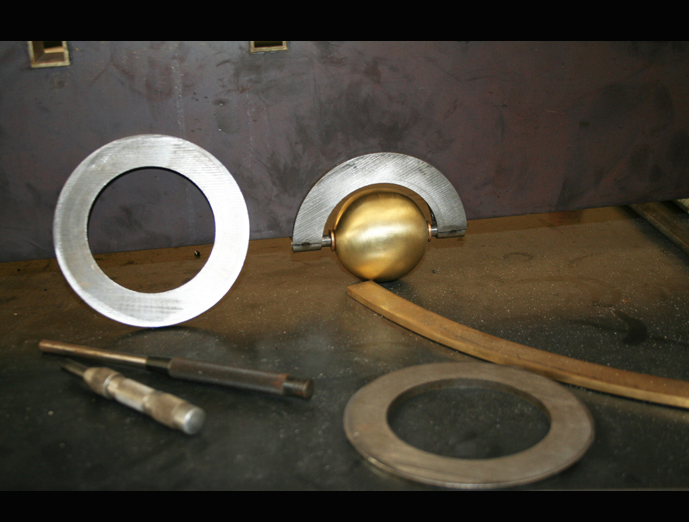About Metal
Metal is as durable as time, and as fluid as a river, as rigid as a rock, or as flexible as a feather.
To a sculptor, metal is liquid.
The choice of metal, how it's worked and how it's used define the craft.
Discover the seductive allure of nature's proudest elements.
WHAT IS METAL?
Metal is defined as a dense, opaque, material with high electrical conductivity, high thermal conductivity, and is usually malleable and ductile, with a crystalline molecular structure. Most metals can be shaped without breaking or cracking. Lead, plutonium and Mercury can kill you, while Copper, Zinc, and Iron help to keep you alive. Bronze statues have survived eons in the open air, while the carcass of an automobile will dissolve after a few years in the rain.
Why Metal? Metals are used in applications which take advantage of their unique properties, be they technical, (wires, cables), practical, (cost, availability), or ornamental, (luster, color). Metals don't burn, are highly repairable, and, of special interest to designers, offer an enormous variety of finish possibilities. Metals are unequaled in the combination of durability, beauty, and cost in applications as diverse as tools, jewelry, prosthetic devices, or furniture. Guitar strings, saxophones, flutes, cymbals, pianos, accordions, harmonicas, singing bowls and the most ancient and simple instrument of all, the gong, all benefit on the magical properties of metal.
Metals are among the most complex materials known. There are 46 base metals and thousands of alloys. Some harden when you hit them, some soften after they are heated (annealed), while others are hardened by heating and rapid cooling (tempering). Besides the obvious qualities of weight, color or cost, there are scores of other properties of metals, such as points of liquidus and solidus, the co-efficients of thermal expansion and of friction, and the ever popular modulus of elasticity.
Alloys And Base Metals. Base metals are those which appear on the periodic table as elements. Alloys are combinations of metals, or metals and other elements. Copper, Gold, Iron and Aluminum are base metals, Brass, Bronze, and Steel are alloys. Any gold, other than 24 Karat, is an alloy. (Trivia question: Is 18K gold 50% gold or 75% gold? It's thought of as 3/4ths gold, which it is, by weight. But by volume, 18K gold is about 1/2 gold, because of its extreme density.)
Alloys are created for many reasons, but usually to blend qualities inherent in the individuals: strength or hardness; corrosion resistance; color. Tin and Copper are the basic elements of the alloy which gave its name to the second great 'Age" of humans, the Bronze Age. This mixture created a metal which was very hard, impervious to weather, and quite beautiful. The next age, the Iron age, utilized an even more abundant metal and later made way for Steel, the defining metal of our time. Steel is a combination of Iron and carbon. Stainless Steel combines Iron, carbon, nickel, and chromium, in varying amounts depending on the qualities desired.
The copper alloys, (Brass, Bronze, Muntz Metal, etc.) are among the most popular because of their great flexibility, durability and beauty.
In addition, copper holds a place of co-uniqueness with gold as the only metals which are not grey.
Forming. The forming of metal can be divided into three broad groups: Casting, Forging, (beating pressing, bending), and machining, (which includes cutting, scraping drilling etc.) Forming can be done with a hammer and anvil, or a milling machine. It is used when shaping curves or angles, or any action which changes the dimension or shape of a piece. Several more exotic forming techniques, (such as sintering and spray forming), are used by industry but these don't affect most civilians.
Joining. Metals can be joined with cold connections or hot ones. Cold connections include screws, rivets, glues, and many others; hot connections include soldering, brazing and welding, which are very different processes.
The choice of joining technique is a complicated one, but should not normally affect the appearance of a piece. You should never see a weld on any of our work.
Finishes. The finishing of metal products is done for both preservation of the metal and for esthetic considerations. For household purposes, a finish locks in the color and texture of the metal, prevents corrosion, and gives a feeling of completion to a piece.
Finishes fall into several broad categories. Textures, which are actually minute deformations of the surface include brushing, sanding, polishing, etc. Coloring finishes, (lacquers, paints), which coat the metal with a relatively think opaque color coat. Patinas, done with acids or other agents which provoke formation of oxides; and clear finishes, lacquers, oils, and waxes, which are often used as a sealer in combination with other finishes.
It's useful to understand that metal cannot actually be "colored", at least not in the sense that woods and fabrics can be. Coloration of metal affects only the surface of the metal and does not penetrate. In the case of paint, it is laid on and allowed to dry. Patinas appear to color the metal itself, but are actually controlled corrosion which forms in the presence of oxygen, and include common oxides such as rust. But each is either a coating, in the case of paint, or a conversion, often microscopic, in the case of patinas. Anodization, commonly used to make aluminum bright yellow, pink, or black, is an electrical conversion of a thin layer of the metal to a bright color, which is controlled by degrees of current, temperatures, etc. An Anodized coating on aluminum is no more than a few millionths of an inch thick. If you scratch this thin surface, the true aluminum beneath reveals itself.
Shaping. We have cataloged many of the different techniques used to form, cut, shape, and finish metal, (available in another publication). Among them are fifteen distinct ways to create a tubular form; three basic ways to cut metals, (slicing, shearing, and machining, all specific methods are variations of these). There are three families of techniques to shape metals: casting, forging, and machining. 3-D printing is a recent addition which falls between casting and machining. We can name eight distinct methods for creating a hole in a piece of metal, only one of which involves a drill.
This knowledge is used to solve problems, and to determine if and how metals are appropriate for your project. We can help you understand the benefits of metals over other materials and how certain choices can make metals useful and appealing where another material might have seemed more obvious. We can help you make choices about using metal efficiently and tastefully. And sometimes we may help you discover that metals aren't called for at all. We know when wood is best, and plastics, and concrete, because we work with these too.
And Finally, Costs. Because it is a commodity, metal prices are subject to the same market forces which control oil, coffee, or bacon. That means that choices of materials are not always decided objectively. Two examples illustrate the capriciousness of this market. At the top of the Washington Monument is a small pyramid of metal which was placed there as a sort of crown to cap the glory of the Father of our Country. It's made of what was at the time thought of as the king (or maybe president) of metals: Aluminum. Since then, mining and manufacturing processes have rendered aluminum serious blows in status.
In 1884 pure aluminum metal was rare and was as valuable as gold. Aluminum actually is the most abundant metal in the earth’s crust, but it does not occur naturally in its pure form. In 1886 an inexpensive method was found for separating aluminum from earth minerals using electricity.
The Guggenheim Museum in Bilbao, on the other hand is clad in one of the more exotic and interesting metals, titanium. But this was a squeaker. The use of Titanium was possible only because of a small window of time during which the metal was rendered affordable by a volatile market, and the buildings owners were able to secure it for the museum.
The Guggenheim Museum In Bilbao, Spain
In daily use, we all have to make choices, compromises and decisions based on cost. But nowhere is false economy more of a danger that in selecting materials for design.The permanence of a design should dictate the choice of material. IKEA uses very little bronze, ebony, or marble, and that's appropriate. You may feel that your work deserves a more permanent status. We can help you do that.
Budgeting with metal. The range of costs of metals is huge. An ounce of gold could buy you 60,000 lbs. of iron. Choices...choices. But there are other considerations, such as availability, ease of use, maintenance, etc, and all of these must be considered. So when the time comes, call us, and together we'll figure out something nice for you.
METAL IS GREEN
One last thing. Metal, which is elemental, can be endlessly recycled. Once it's out of the ground it need never go back. Your fridge might once have been a Model T Ford; your wedding ring might once have been a tiara. The mutability of metals is unique among common materials. You can't do it with wood, or with fabric. And this is a great reason to choose metal.














